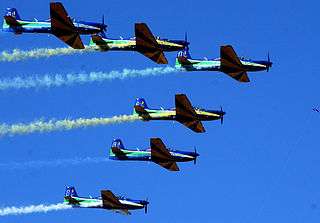Smoke Squadron
The Aerial Demonstration Squadron (Portuguese: Esquadrão de Demonstração Aérea), popularly known as Smoke Squadron (Portuguese: Esquadrilha da Fumaça) is the Brazilian Air Force's air demonstration squadron. Its first display was on 14 May 1952 over Copacabana beach, using the North American T-6 Texan. The team used the T-6 from its formation until 1968, when it switched to the French Aérospatiale (Fouga) CM.170-2 Super Magister jet, called T-24 in FAB service. However, this model proved unsuitable to Brazilian conditions and, in 1972, the squadron reverted to the T-6, which was used until 1977.
 | |
| Country: | Brazil |
|---|---|
| Aircraft currently flown: | Embraer EMB 314 Super Tucano |
| Sponsor: | Brazilian Air Force |
| Base airfield: | Academia da Força Aérea, in Pirassununga |
| Colors: | Green, Yellow and Blue |
| Date formed: | May 14, 1952 |
| Crest/logo: |  |
The EDA was disbanded in 1977, but reformed on 8 December 1983 using Neiva T-25 Universal piston-powered aircraft, soon to be replaced by the then-new Embraer EMB-312 Tucano turboprop trainer. At the time the EDA's aircraft were painted a bright red scheme, which has since been superseded by the current gloss blue.
Aircraft
The aircraft used by the EDA have been, in chronological order:
- North American T-6 Texan for 1225 displays;
- Aérospatiale (Fouga) CM.170-2 Super Magister for 46 displays;
- Neiva T-25 Universal for 55 displays;
- Embraer EMB-312 Tucano with more than 2000 displays as of 2010;
- Embraer EMB-314 Super Tucano, being the two first ones delivered on September 30, 2012. In the subsequent two years, Super Tucanos have replaced the Tucano in the Smoke Squadron [1]
Objectives

- To bring together civilian and military aeronautical communities
- To contribute towards a better integration between the Air Force and the other Armed Forces
- To represent the Brazilian Air Force in Brazil and abroad
- To encourage youngsters to take up civilian and military aeronautical careers
- To show the quality of the Brazilian aerospace industry
- To show the capabilities of the Brazilian Air Force crews.
Gallery
References
| Wikimedia Commons has media related to Esquadrilha da Fumaça. |
External links
- Official website (in Portuguese)
- Official website (in English)
- Video showing the Esquadrilha da Fumaça in action


.jpg)
.jpg)
